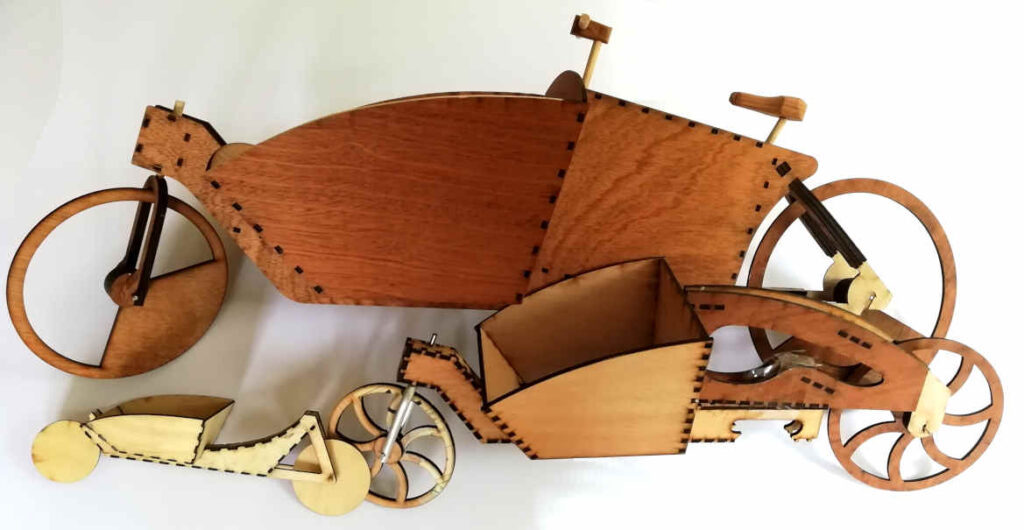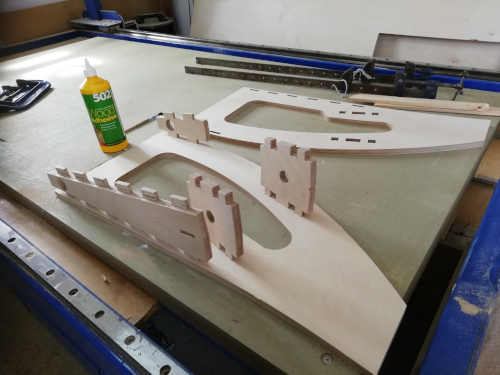Over the last year or so I have been developing a plywood cargo bike, in the hope it will be of some use to somebody apart from me. After visiting the wiki houses in Amsterdam and seeing how cargo bikes seemed to be the life blood of the city, we began wondering if the two concepts could be brought together somehow. If you can make plywood houses why can’t you make plywood cargo bikes, and make them so they are cheaper and simple enough for almost anybody to make. We became convinced that cargo bikes are the future of urban transport, and plywood cargo bikes could play role in making that future a reality. They can be used to take children to school, to do the weekly shop, to make deliveries, and trades people can take their tools to site. They do not use fossil fuels, they do not pollute the environment, and they are excellent for mental and physical well-being.
Design and materials
The aim has been to develop a design that could be constructed by any body with basic woodworking skills for considerably less money than a commercial cargo bike. Plywood is cheaper and more environmentally friendly than steel, and it does not rust. All the plywood and aluminium parts are cut to shape using CNC machines, tubing can be cut to length by suppliers, and standard bicycle spare parts can be bought online or from cycle shops. Although some specialised hand tools are required, there is no welding or machining involved . The wooden frames and cargo container are glued together and varnished, and then everything else is bolted together. The design is licensed under creative commons. The CAD files and a full list of tools and materials needed can be downloaded from the link to the master file at the bottom of the page. If you are still not convinced that plywood is a suitable material I suggest you listed to this BBC program that talks about plywood aircraft.

Laser cut models
Cutting files

Here is an image of the cutting files to make all the plywood and alumiunum parts.
The dfx master files can be downloaded from the links below. This will also give you a list of all the parts and the tools you will need.
The master files for the bikes should be split up into 4 drawings. Take two dxf cutting files of the plywood parts to a company with a large CNC router, and two dxf cutting files of the aluminium parts to a company able to laser cut metal. Each file will be used to cut one thickness of material. The rear drop-outs will also need to be slightly bent using an hydraulic press. Most engineering workshops will have one of these.
The right hand rear drop-out has to be drilled and tapped as will the bottom steering lever, but with the right tools this is easy to do.
Before you glue the plywood parts together they will have to be cleaned up, and the joints checked (they should fit together easily but not be too loose). Then you can then glue the frames together using good quality slow cure adhesive, and some G clamps. After that, give the frames a good sanding all over and then several coats of yacht varnish.
You should now be ready to assemble the rest of your bike.
Images of the construction process

The plywood parts are cut on a large flatbed CNC router, using a 4mm diameter cutter. Although this size of cutter seems a little small for cutting 18mm thick plywood, it was chosen to keep the dog bones in the corners of the joints as neat as possible. The cutter seems to be up for the task and all the drawings have the dog bones incorporated.


Wik-E-Bike Trailer
The trailer has been developed to carry larger, heavier loads than a cargo bike. Like the bikes it is made from plywood parts cut on a cnc router, some aluminium plate, and off the shelf bicycle parts. Over run brakes are part of the design, but it will need a small bicycle ball hitch.
Download the plans
The dxf files given here are free to download and use, but there will be errors. Sadly I do not have the resources to develop these projects further at the moment. To view or edit the files you can use LibreCad, a free, open source CAD program, available from here: https://librecad.org/. These Cargo bikes have been designed for use with wheel hub motors (the bigger the wattage the better). It is possible to use mid frame motors, but they will need aluminium mounting plates set into the main frame .
If you use any of the files and make a machine please share photos. If you have any comments or make any improvements I would love to hear from you.




Britt Klews
thank you. this will be used to help a young woman in namibia make cargo bikes in her disadvantaged community
aaron.moore
Hi Britt
This is brilliant. Thank you for letting me know. If you can please keep me posted on progress, and if there is any way I can help with adapting the design so it can be made where you are I would be delighted.